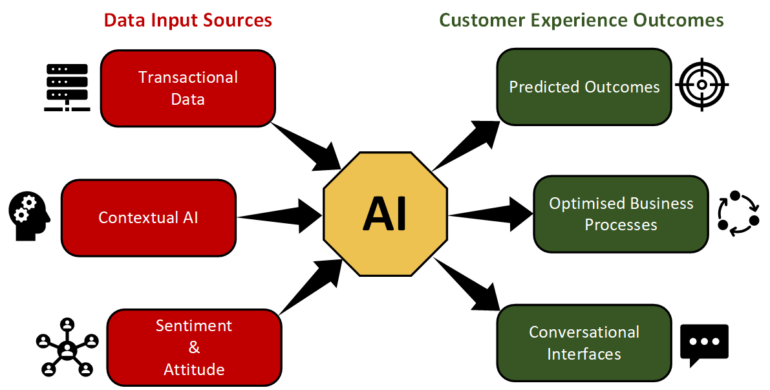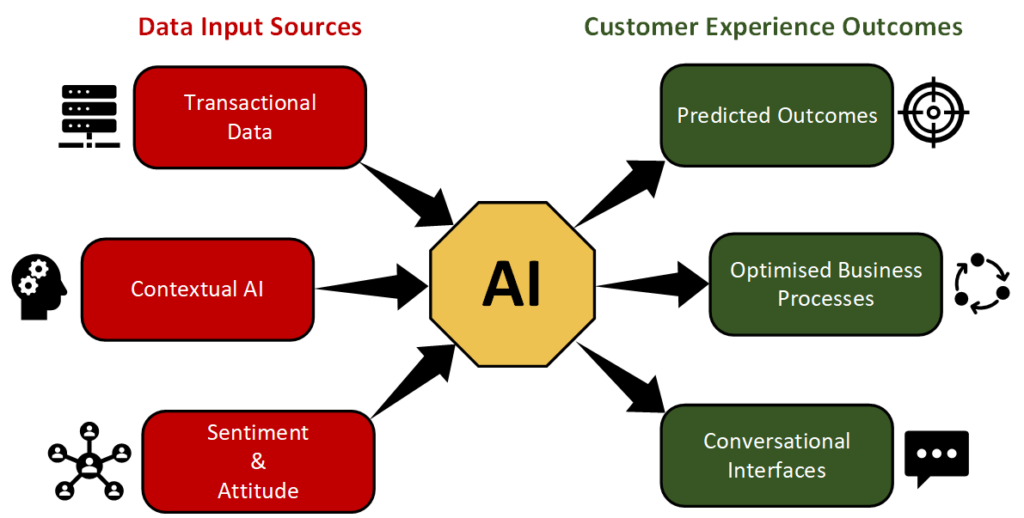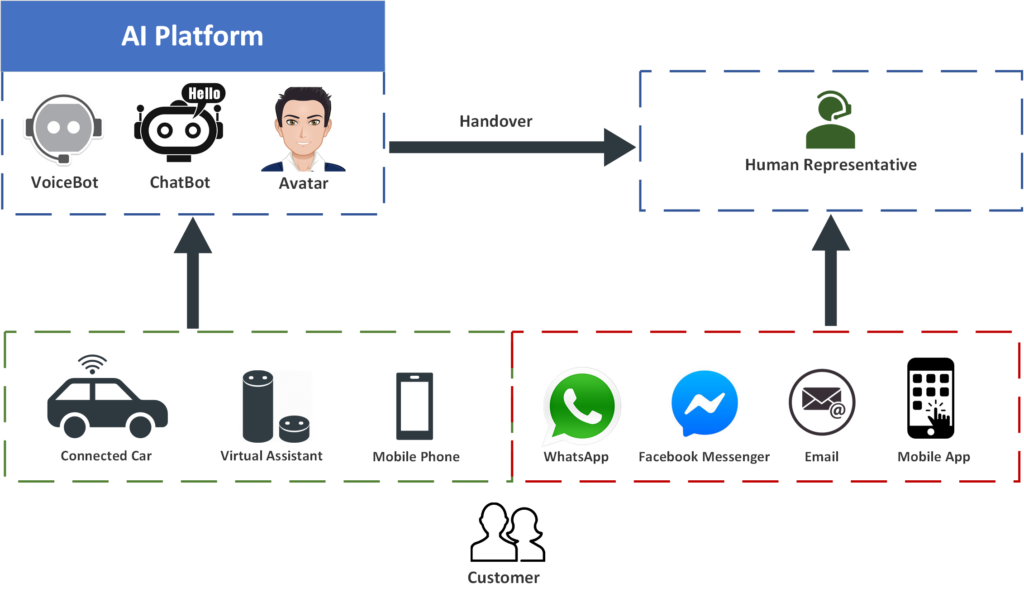In the last few years, organisations started focusing on improving customer experience. Traditionally, customer experience was achieved by manually analysing large volume of datasets in order to identify patterns. Then Covid-19 happened. Customer consumption behaviour and expectation have drastically changed. A sudden shift in digital channels took place which in turn triggered new forms of interaction between organisations and their customers. The massive shift to digital channels by customers, has forced many organisation to consider AI enabled analytics for transforming their customer experience. Yet, despite the growing exploration of AI, only 6% of AI Proof of Concepts will progress towards production.
AI is being used today to analyse data in new ways:
- Transactional Data: Customer demographics, historical transitions, buying habits and past touch points with the organisation.
Example: A customer who used a website to search for specific services products can lead to proactive conversation with sales/support “Hello Mr/Ms customer I see you have been considering our new drones insurance on our website, what type of a drone are you considering insuring?”
- Contextual AI: combining contextual data from customers (searches, life events, trips and their devices (location from phone, personal assistants, etc) and adding intelligence to it.
Example: empowering service representatives with customer context around their interaction history along with a suggested response that goes something like this “Hello Mr/Ms customer, I see you have spent 45 minutes with our customer service a week ago on disputing to a charge on your card and it looks like the issue is still unresolved. Allow me to help you get that resolution today”.
- Customer Sentiment: Monitor different social media platforms to identify attitude towards your organisation’s brand. This covers monitoring and analysing video, audio, images and text generated around your brand.
Example: Customers are complaining on social media about your long wait time on the phone and rude customer service. This will help identify dissatisfaction points and overall attitude towards your brand.
Applying AI to combined collected data will help identify trends buried in oceans of data to provide quicker business outcomes.
Expected Business Outcomes
-
Predicted Outcomes
AI identifies and predicts customers that are likely to buy based on past purchases, website click through, call history with service/sales, thus enabling sales to focus on leads that are likely to convert.
-
Optimised Business Processes
AI today, can use new data sets that were not available in the past to price services. For example, in insurance, AI-enabled analytics use data on climate change outlook, weather forecast, widespread epidemic, real-time competition pricing, customers social media, etc. This allows for dynamic pricing based on multitude of key variables.
-
Conversational Interfaces
Today natural Language Processing (NLP) enables customer to have human-like conversations with chat bots, voice bots and avatars via their connected cars, mobile phones, Alexa/Siri/Google for level 1 service support or to facilitate a simple online sale.
Diagram 2 is an example of how customers are interacting with organisations today. Customers are using their mobile phones, virtual assistants (Alexa, Siri, Google), their connected cars to interact with organisations. Customers are also expecting self-service options such as voice-bots, chat-bots, avatars, etc.
In the above diagram, AI platform enables human-like conversations with customers. This leads to resolving level 1 service requests, facilitating online sales, qualification, routing to appropriate service department, identity verification, etc. The realised business outcomes include:
- Automating level 1 support leads to significant costs savings.
- Less wait time during peak hours leads to improved customer experience.
- Providing human representatives with customer intelligence enables them to provide customised services and make relevant product/service recommendation.
Challenge
There are many challenges in AI adoption and one of the top obstacles clients face, is identifying the right use cases to test. How do you select the right use case that will add the most business value?
Approach
First, I suggest analysing your customer journey and identifying dissatisfaction points. This should involve a cross functional team representing the various business divisions within the organisation. However, a common mistake I often see is the team selected to evaluate this is exclusively from IT. This leads to wrong use cases being selected which in turn leads to lack of business buy-in.
Second, consider use cases that have been proven to deliver desired outcomes in other organisations in the same industry. I often evaluate a handful of relevant use cases with clients, then select one or two to validate.
Third, The final step before deployment is identifying the desired business outcomes and relevant KPIs to measure success of the proof of concept. Common KPIs often include cost optimisation, increased revenue, customer satisfaction (Net Promoter Score), customer retention rate, cross sell/up sell, etc.
Fourth, you need to confirm that there is no bias in the data or algorithm used. This is a critical step that is often missed.
Validation
Simplicity and speed are the key to a successful proof of concept. I often see complex proof of concept environments that run for months with no clear outcome (that is one reason for only 6% of PoC progress to production).
I have helped clients setup a validated cloud based lab (in less than a day) to test the one or two use cases selected. After a month, clients have enough insight to build an effective AI adoption roadmap and progress towards production.
Are you currently looking to improve your customer user experience but not sure where to start? Are you stuck in an endless PoC loop?
Feel free to reach out for an informal conversation. I am happy to share industry best practices and proven strategies for improving customer experience.
I hope you have found this post informative and thank you for reading.
Regards,
Nick





Mark
November 16, 2020Nice article. CX and AI is certainly the new Fish n Chips! 🙂
Mark
Virtual Tarzan
November 19, 2020Interesting analogy! I am tempted to guess what you had for dinner ..
T
November 17, 2020Finding dissatisfaction points is not easy. This is the problem IMO.
T
Virtual Tarzan
November 19, 2020Excellent point. I suggest a method that has been used successfully by clients. To identify the points of disconnect and dissatisfaction in your customer journey, analyse the customer journey end to end. For example, your customer touch points might a sales agent, call centre, website. Support, etc. Next, look for repeated interactions with your organisation. Repeated calls to customer service might mean unresolved issues. Visiting the same web page repeatedly could also suggest an issue with website. High level of cancellations or abandoned carts could also suggest a technical issue and so on.